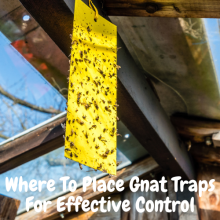Best Homemade Gnat Traps That Really Work | HelpHowTo
Summary of Best Homemade Gnat Traps That Really Work
Gnats can be a maddening nuisance, swarming around ripe produce and houseplants. While chemical insecticides are an option, many prefer homemade gnat traps using safe, household ingredients. First, identify the type of gnat – fruit flies, fungus gnats, drain flies or mosquitoes. Popular traps include apple cider vinegar with dish soap, narrow-neck funnel designs with sweet baits, sticky surfaces coated with honey or oil, shallow vinegar dishes with soap, and bowls of fermenting fruits.
For fungus gnats in houseplants, bury shallow soapy water dishes in the soil. Prevention is also key by eliminating moisture sources, maintaining cleanliness, sealing entry points, and proper drainage. Whichever trap you choose, placement near the gnats’ sources is crucial. These affordable DIY solutions provide an effective, natural way to control gnats.

Our Top 5 Recommended Indoor Genat Traps
Sick of pesky gnats invading your home? Discover the top 5 indoor gnat traps to banish these annoying insects for good! Our expert reviews reveal the most effective, easy-to-use traps. From powerful UV attractants to eco-friendly vinegar traps, we’ve thoroughly tested and ranked the best solutions. Check Now

Dealing with Gnats? Try These Homemade Traps That Actually Work
If you’ve ever had a run-in with gnats, you know just how maddening these tiny flies can be. They seem to multiply overnight, swarming around ripe produce, hovering over houseplants, and making any time spent in the kitchen or outdoors a nuisance. While chemical insecticides are an option, many prefer to avoid harsh pesticides and opt for more natural, homemade gnat traps instead. The good news is that these DIY solutions are affordable, effective, and use safe, household ingredients.
Identify What Type of Gnat You’re Dealing With
Before you decide on a trap, it’s wise to first identify exactly what type of gnat you’re dealing with. The most common gnats are fruit flies, fungus gnats, drain flies, and mosquitoes. Fruit flies are drawn to overripe fruits and vegetables, sweet liquids, and fermentation. Fungus gnats are found near moist potting soil and love mushroom compost. Drain flies breed in the sludge and gelatinous buildup that can accumulate in sink drains. And mosquitoes, while technically not gnats, often get lumped in and are attracted to standing water. Identifying which species has invaded will help determine the most suitable trap.
Apple Cider Vinegar Trap
One of the most popular and effective homemade gnat traps is the apple cider vinegar trap. The vinegar’s fruity aroma lures the gnats in, while a few drops of dish soap causes them to sink and drown once they land on the surface. Simply mix together a half cup of apple cider vinegar with 1 tablespoon of sugar and 1 teaspoon of dish soap in a small bowl or jar. Cover with plastic wrap and poke several small holes in the top. You can even use a funnel inserted into the jar to make it easier for gnats to get in but harder to escape.
Variations of this vinegar trap include using white vinegar, balsamic, or any other vinegar you have on hand in place of apple cider. Some add a piece of overripe fruit like a banana or melon to further entice the gnats. And a few drops of lemon-scented dish soap seems to boost the attractant. Just be sure the vinegar mixture is shallow to allow the gnats to drown easily.
The Funnel Design
Another classic homemade gnat trap is the funnel design. You’ll need a narrow-necked bottle like or even a funnel or paper cone inserted into a jar or bottle. Add a few tablespoons of ripe fruit, or other sweet bait to the bottom. Gnats can easily fly into the wide opening but struggle to exit the narrow neck, becoming trapped inside. You can even disguise the trap by wrapping or painting the outside to blend with décor if desired.
Plate with Honey
For a simple sticky trap, coat a plate, bowl, or strip of cardboard with something gooey like honey, maple syrup, vegetable oil, or petroleum jelly. Gnats are drawn to land on the sticky surface and become stuck, unable to escape. Adding bright colors or patterns with a marker can make the trap even more attractive. Sticky traps have the potential downside of trapping other insects you don’t intend to catch, so use them carefully.
Vinegar With Drops of Dish soap
Similar to the vinegar traps, you can also set out small dishes of vinegar combined with a few drops of dish soap or scented body wash. Gnats are lured by the vinegar scent but drown upon contact once the surface tension is broken. Adding a sprinkle of sugar or pieces of fruit makes the liquid even more irresistible to them.
Bowl of Fermenting Fruit
Other effective homemade traps include leaving out a bowl of fermenting fruit like bananas, berries, melons, or pineapple to draw fruit flies. The decaying, sugary pieces are what they crave for reproduction. Ditto for leaving out a shallow bowl or a simple mixture of water, sugar, and a sprinkle of yeast. Once the liquid begins to ferment, the gnats dive in but then drown.
Shallow Dishes Filled With Soapy Water
For fungus gnats plaguing houseplants, some find success with placing shallow dishes filled with soapy water and leaving them buried near the surface of the soil. The gnats are drawn to the moist soil environment but land in the soapy death trap. Saucers of sand soaked in vegetable oil are said to work as well, capturing any gnat that makes contact. Essential oils like lemongrass, peppermint, or cinnamon may help repel fungus gnats if spritzed on the plant soil too.
Focusing on Prevention
While traps can certainly provide satisfying gnat removal, focusing on prevention is key too. Start by eliminating any sources of standing water or moisture around the home. Check for leaks under sinks, condensation on windows, and drainage issues. Keep kitchen counters scrupulously clean and clear of residues, washing dishes promptly. Be vigilant about overripe produce and dispose of spoiled food quickly. Seal off entry points by caulking cracks and using window screens. And make sure your drainage and vent systems are in good working order.
No matter which homemade gnat trap you choose, placement is crucial to success. Since different types of gnats have varied preferences, experiment with placing the traps near potential sources like garbage disposals, compost bins.

Our Top 5 Recommended Indoor Genat Traps
Sick of pesky gnats invading your home? Discover the top 5 indoor gnat traps to banish these annoying insects for good! Our expert reviews reveal the most effective, easy-to-use traps. From powerful UV attractants to eco-friendly vinegar traps, we’ve thoroughly tested and ranked the best solutions. Check Now
FAQs and Answers
How often should homemade gnat traps be replaced or refreshed?
Homemade gnat traps should be refreshed or replaced every 5-7 days for best effectiveness. Here are some more specific guidelines:
- Vinegar traps – The vinegar mixture should be replaced weekly as the aroma and attractiveness diminishes over time.
- Fruit/vegetable traps – Refresh with new pieces of ripe/rotting produce every 4-5 days before they dry out completely.
- Sticky traps – These can last 1-2 weeks, but should be replaced once completely coated with dead gnats.
- Soap water traps – The soapy water tends to get dirty quickly, so swap it out every 5-7 days.
In general, you’ll know it’s time for a refresh when the trap stops catching many gnats. Regularly maintaining the traps by changing out the bait ingredients ensures peak attractiveness and effectiveness. It’s also a good idea to rinse out and clean the trap containers before setting them back up with new lures.
Are there any seasonal differences in what homemade gnat traps work best?
Yes, there can be seasonal differences in which homemade gnat traps work best depending on the types of gnats that are more prevalent:
Spring/Summer:
- Fruit fly traps tend to work better in spring and summer when ripe fruits and vegetables are abundant. Things like vinegar and rotting produce traps are very effective at luring fruit flies.
- Drain fly traps using vinegar or rotting fruit/vegetable material are also good for this time of year when drain flies may emerge.
Fall:
- As fruits and vegetables are being harvested, fruit fly populations may surge, so produce-based traps remain useful in early fall.
- Fungus gnat traps aimed at houseplants become more important as plants are brought inside for winter.
Winter:
- With fewer fruits around, vinegar-based traps become less attractive to fruit flies in winter.
- But fungus gnat traps using potato pieces, soap and water near houseplant soil are essential for controlling these pests overwintering indoors.
- Drain fly traps may still be needed depending on indoor conditions.
So in summary, fruit/produce traps are best in warmer months, fungus gnat traps are most important in winter for indoor plants, and drain fly traps can work year-round. Matching the seasonal gnat activity is key for choosing the right homemade trap.
How can homemade gnat traps be made more visually appealing?
There are several ways to make homemade gnat traps more visually appealing if you plan to use them indoors:
- Use decorative containers
Instead of plain bowls or jars, opt for prettier glasses, vases, or mason jars to hold your vinegar or soap and water traps. You can even paint the outside of glass containers. - Disguise with decorative elements
Wrap plain trap containers with twine, burlap, or patterned paper to camouflage them. Place traps inside larger decorative bowls or vases and surround with rocks, marbles or greenery. - Choose appealing bait
For fruit or vegetable traps, use slices of attractive produce like pineapple or berries rather than rotten, mushy pieces. The bright colors look nicer. - Add essential oils
Add a few drops of essential oils like lemon, orange or peppermint to vinegar traps to provide a fresher scent. - Use pretty paper funnels
For funnel-style bottle traps, use decorative cupcake liners or patterned paper to make a pretty funnel insert. - Blend with decor colors
Paint or wrap traps in colors that match your room’s decor so they blend in better with furnishings. - Use enclosed containers
Opt for clear food storage containers or large mason jars with tightly sealed lids to contain any unpleasant odors.
The key is getting creative with materials and decorative elements to disguise the traps as attractive home accents rather than unsightly pest control. With some effort, you can have effective gnat traps that don’t detract from your home’s style.
Are there any plants or herbs that can help repel gnats naturally?
Yes, there are several plants and herbs that can help naturally repel gnats due to their strong scents and properties:
Herbs:
- Basil – The strong scent of basil is said to deter many insects, including gnats.
- Mint (peppermint, spearmint) – Mint’s menthol aroma repels gnats and other pests.
- Lemongrass – The citrusy lemongrass scent confuses gnats’ sense of smell.
- Lavender – Gnats dislike the floral aroma of lavender plants.
- Tansy – This herb contains compounds that are naturally insect repelling.
Other Plants:
- Citrus trees/plants – The d-limonene in citrus peels repels gnats and fruit flies.
- Eucalyptus – The strong menthol-like smell drives gnats away.
- Marigolds – These flowers have a distinctive scent that deters many pests.
- Herbs like rosemary and sage also have insect repelling properties.
You can grow these plants indoors in pots or crushed and used as natural room fresheners. Outdoors, planting them around patios, gardens or entry points creates a gnat-repelling barrier. Some people even make homemade gnat sprays by soaking the herbs/plants in water and spraying around the home.
While not a complete solution, combining gnat-repelling plants with other prevention and trap methods can provide an effective, eco-friendly way to control gnat populations naturally. The strong scents interfere with gnats’ sense of smell used to find food sources.
How do you properly and safely dispose of homemade gnat traps?
Here are some tips for properly and safely disposing of homemade gnat traps:
Vinegar Traps:
- Pour out the liquid mixture through a fine mesh strainer to catch any dead gnats.
- Rinse out the container thoroughly with hot soapy water.
- The dead gnats can be flushed down the toilet or wrapped in a sealed plastic bag and discarded with regular trash.
Sticky Traps:
- Carefully remove the sticky surface or cardboard and wrap it fully in plastic wrap or a bag to contain it.
- Dispose of the wrapped sticky trap in the outdoor garbage can to avoid attracting more pests indoors.
Fruit/Vegetable Traps:
- Wearing gloves, remove rotting produce pieces and dead gnats into a sealed plastic bag.
- Discard the bag in an outdoor trash can.
- Thoroughly clean and disinfect the trap container.
Soap/Water Traps:
- Strain out any dead gnats through a mesh strainer.
- The soapy water mixture can be poured down the sink followed by hot water to rinse away residue.
- Clean the container with hot soapy water.
General Tips:
- Avoid dumping out gnat traps in your home or garden where the dead insects could attract more pests.
- Seal up dead gnats completely before disposing outside.
- Use gloves and wash hands thoroughly after handling trap contents.
- Disinfect and clean trap containers before reusing.
Proper disposal prevents spreading potential bacteria and stops the release of pheromones that could draw more gnats inside. Taking care avoids creating new pest issues in the process of eliminating existing gnat problems.

Our Top 5 Recommended Indoor Genat Traps
Sick of pesky gnats invading your home? Discover the top 5 indoor gnat traps to banish these annoying insects for good! Our expert reviews reveal the most effective, easy-to-use traps. From powerful UV attractants to eco-friendly vinegar traps, we’ve thoroughly tested and ranked the best solutions. Check Now





